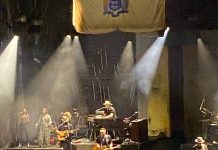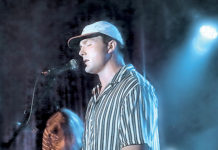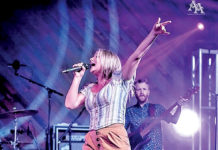By Muriel Smith
HIGHLANDS – The hard work, dedication and patience, to say nothing of energy and pride in their hometown has finally paid off for the Highlands Historical Society. They now have the Historical Society of Highlands exhibit at the Twin Lights.
The exhibit, manned by volunteers and portraying a very intimate peek at this community over more than 200 years, is open Saturdays and Sundays from 10 a.m. to 4 p.m. in the former lighthouse keeper’s quarters on the south side of the building.
The historic Twin Lights is owned by the State of New Jersey, which maintains the lighthouse exhibit and museum in the north lighthouse keeper’s quarters with the Twin Lights Historic Association, where access is also gained to one of the two towers for ambitious climbers.
But for Highlands, the exhibit in the south quarters tells the story of the entire community that surrounds the famed lighthouse, known for everything from being at one time the brightest beacon on the east coast, the site of Marconi’s first successful wireless message to a New York newspaper, and the locale where the Pledge of Allegiance was recited for the first time to its current status as a national Historic Landmark Site.
But the history of Highlands, the community, goes deeper than that, says Society president Russell Mount, a proud eighth generation native of the town founded in 1900. And the exhibit shows it all, the beauty, the warts, the excitement, and the prestige. The exhibit shows both in displays and photos what sets this community apart from other riverfront towns.
Included among the treasures on display is a trophy won by Gertrude Ederle, the first woman to successfully swim the English Channel. Ederle, a summer visitor to Highlands during the 1920s, has always proudly proclaimed she first learned to swim in the Shrewsbury River when her father lowered her into the water from a dock near Bahrs Restaurant. On her frequent visits back to the borough after her successful swim in 1926, Ederle always credited the swift currents at the Highlands Bridge as the means for giving her the strength to swim the Australian crawl across the Channel.
Another exhibit tells the story of an early American tavern, one originally known as the Woodward/Schenck tavern, which was in existence in the 19th century, before Highlands was incorporated. The tavern was built on Nimrod Woodward’s property near the Highlands Bridge, and its remains were uncovered during excavation for the Captain Joseph Azzolina Bridge, which spans the Shrewsbury River and replaced the bridge built in 1932.
Included in this display are shards, pieces of pottery, and some of the shells and bones remaining in the “midden”…basically a trash dump…. uncovered in the bridge excavation. The tavern gained its dual name both from Woodward the property owner and Peter Schenk, who acquired the property in 1830. This exhibit also includes at least one initialed cuff link from an earlier time, a silver half-real Mexican coin, and some thimbles and pins apparently swept up with trash.
Another exhibit shows the importance of the lighthouse and grants a peek into the lives of the lighthouse keepers who manned the lights, including photos of some of the keepers as well as some of their descendants, names still well known in the borough. There is a brief reference to Robert Bloome, a former Sailor who is the borough’s only recipient of the Congressional Medal of Honor, commemorating his role in the Spanish American War in 1898. Bloome served as third assistant lighthouse keeper from 1906 to 1910.
There are exhibits recalling the gold rush of 1948, the Prohibition years of the 1920s, and the hardworking clammers who built the community and whose descendants still live in the borough, many continuing to ply the same trade as their ancestors.
Russell Card, who has been part of the Historical Society from its beginning, can tell most of the stories about most of the exhibits by heart, adding little known facts garnered from conversations with his own ancestors as well as his own studies of Highlands history.
“This museum is a dream come true for all of us who have worked so hard to show what Highlands is all about,” Card said. “I couldn’t be any more proud of what we’ve done here.”














